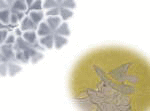
『 Our personal sympathies are with the flower-arrangements of the tea-master rather than with those of the flower-master.
The fomer is art in its proper setting and appeals to us on account of its true intimacy with life.
We should like to call this school the Natural in contradiction to the Natural-esque and Formalistic schools.
The tea-master deems his duty ended with the selection of the flowers, and leaves them to tell their own story.
Entering a tea-room in late winter, you may see a slender spray of wild cherries in combination with budding camellia; it is an echo of departing winter coupled with the prophecy of spring.
Again, if you go into a noon-tea on some irritatinly hot summer day, you may discover in the darkended coolness of the tokonoma a single lily in a hanging vase; dripping with dew, it seems to smile at the foolishness of life.
A sole of flowers is interesting, but in a concerto with painting and sculpture the combination becomes entrancing.
Sekishiu once placed some water-plants in a flat receptacle to suggest the vegetation of lakes and marshes, and on the wall above he hung a painting by Soami of wild ducks flying in the air.
Shohs, another tea-master, combined a poem on the Beauty of Solitude by the Sea with a bronze incense burner in the form of the beath.
One of the guests has recorded that he felt in the whole composition the breath of waning autumn. 』
(The Book of Tea-Flowers, pp.105-106, Charles E. Tuttle Co., Rutland, Vermont, Tokyo, Japan)
The natural is the best Artistic expression itself.
Image Designer: Izumi Mori

 『The birth of the Art of Flower Arrangement seems to be simultaneous with that of Teaism in the fifteenth century.
『The birth of the Art of Flower Arrangement seems to be simultaneous with that of Teaism in the fifteenth century. 『When a tea-master has arranged a flower to his satisfaction he will place it on the tokonoma,the place of honour in a Japanese room.
『When a tea-master has arranged a flower to his satisfaction he will place it on the tokonoma,the place of honour in a Japanese room. 『Why not destroy flowers if therby we can envolve new forms ennobling the world ideas?
『Why not destroy flowers if therby we can envolve new forms ennobling the world ideas?
 『Yet even in the case of pot flowers we are inclined to suspect the selfishness of man.
『Yet even in the case of pot flowers we are inclined to suspect the selfishness of man.